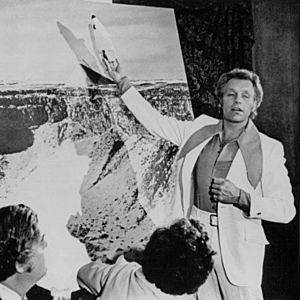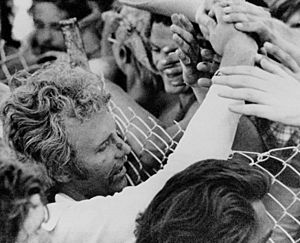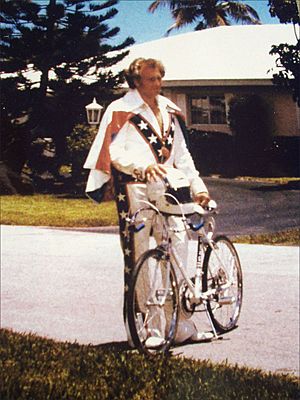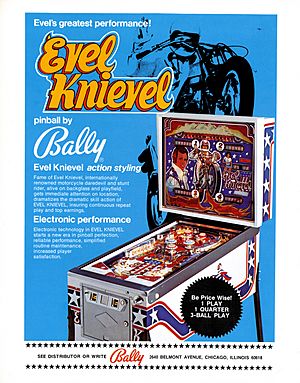Evel Knievel facts for kids
Quick facts for kids
Evel Knievel
|
|
|---|---|
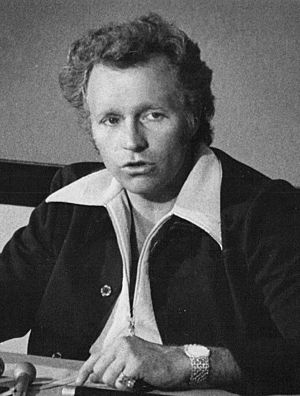
Knievel c. 1974
|
|
| Born |
Robert Craig Knievel
October 17, 1938 Butte, Montana, U.S.
|
| Died | November 30, 2007 (aged 69) Clearwater, Florida, U.S.
|
| Resting place | Mountainview Cemetery, Butte, Montana, U.S. |
| Occupation | Stunt performer |
| Known for | Motorcycle stunts |
| Spouse(s) |
|
| Children | 4, including Robbie |
| Relatives | Pat Williams (cousin) |
Robert Craig "Evel" Knievel (born October 17, 1938 – died November 30, 2007) was a famous American stunt performer and entertainer. He became known for his daring motorcycle jumps, attempting over 75 ramp-to-ramp stunts. Evel Knievel was so influential that he was inducted into the Motorcycle Hall of Fame in 1999. He passed away in Clearwater, Florida, in 2007, at the age of 69, due to lung disease.
Contents
Evel Knievel's Amazing Life
Early Years and Daredevil Dreams
Evel Knievel was born in Butte, Montana, on October 17, 1938. He was the first of two children. When he was young, his parents divorced, and he and his brother were raised by their grandparents.
When Knievel was eight, he saw a Joie Chitwood auto daredevil show. This show inspired him to become a motorcycle daredevil himself. He later left high school and worked in copper mines. He was fired from one job for doing a motorcycle-like wheelie in a huge earth mover. This accidentally knocked out power to the city for hours!
Knievel got his famous nickname, "Evel," after being arrested in 1956. He was in jail with another person named "Awful Knofel." This led to Knievel being called "Evel Knievel."
Trying New Challenges
Knievel loved thrills and challenges. He competed in professional rodeos and ski jumping events. In 1959, he even won a championship in ski jumping. After serving in the United States Army, he returned to Butte. There, he met and married his first wife, Linda Joan Bork.
He also started a semi-pro hockey team called the Butte Bombers. To promote his team, he arranged a game against the Czechoslovakian Olympic ice hockey team. Knievel was ejected from the game, and the game's money went missing.
To support his family, Knievel started a guide service for hunters. He even hitchhiked to Washington, D.C., with elk antlers to raise awareness about elk culling. He met with important government officials, and the culling was stopped years later.
Knievel later joined the motocross circuit. After a motocross accident, he became an insurance salesman. He learned a lot about success from his boss, W. Clement Stone. Knievel later opened a Honda motorcycle dealership in Washington state. There, he learned how to do a "wheelie" and ride standing on the bike seat.
Becoming a Stunt Legend
Knievel remembered the daredevil show he saw as a boy. He decided to create his own motorcycle stunt show. He did everything himself, from renting the venue to selling tickets. His first show featured him jumping over a box of rattlesnakes and two mountain lions! He landed short, hitting the snake box, but was safe.
Knievel soon realized he needed sponsors to make more money. He teamed up with Bob Blair, who supplied motorcycles. Blair wanted to call the show "Evil Knievel." Knievel changed it to "Evel" because he didn't want to seem like a Hells Angels rider.
His first official show as "Evel Knievel" was on January 3, 1966. He later tried a new stunt where he jumped over a speeding motorcycle. He jumped too late and was hit by the bike, ending up in the hospital.
After recovering, Knievel started jumping cars. He would add more cars each time to keep people interested. On June 19, 1966, in Missoula, Montana, he tried to jump 12 cars and a cargo van. He didn't get enough speed and crashed, breaking his arm and several ribs. This crash, however, brought him a lot of publicity.
With each successful jump, people wanted him to jump even more cars. On March 25, 1967, he cleared 15 cars in California. But on July 28, 1967, he crashed again while attempting the same jump. He suffered a serious concussion. He returned to finish the show a month later, but crashed again, breaking his wrist, knee, and ribs.
Evel Knievel first gained national attention on March 18, 1968. He appeared as a guest on Joey Bishop's late-night talk show.
The Caesars Palace Jump
While in Las Vegas in 1967, Knievel saw the fountains at Caesars Palace. He decided he would jump them. He tricked the casino CEO into meeting him by pretending to be from ABC and Sports Illustrated. The jump was set for December 31, 1967.
Knievel filmed the jump himself. On the day of the jump, he lost his last $100 at blackjack. Then he had a drink and headed outside. As he took off, he felt his motorcycle slow down. He landed short, crashing onto a safety ramp. The handlebars were ripped from his hands, and he tumbled onto the pavement.
Knievel suffered many injuries, including a crushed pelvis and femur, and fractures to his hip, wrist, and ankles. He also had a concussion. Despite the severe crash, Knievel became more famous than ever. The Caesars Palace jump was his longest attempted motorcycle jump at 141 feet.
Record-Breaking Jumps
To stay in the news, Knievel planned his biggest stunt: a motorcycle jump across the Grand Canyon. However, the U.S. government would not allow him to jump the Grand Canyon. So, he looked for other ideas. While flying, he saw the Snake River Canyon. He found a spot in Twin Falls, Idaho, that was wide and deep enough. He leased the land to stage his jump.
On January 7–8, 1971, Knievel sold over 100,000 tickets for two shows at the Houston Astrodome. On February 28, he set a new world record by jumping 19 cars with his Harley-Davidson XR-750. He held this record for 27 years.
On May 10, Knievel crashed while trying to jump 13 Pepsi trucks. He broke his collarbone, right arm, and both legs. On March 3, 1972, he crashed again after a successful jump. He reportedly broke his back and had a concussion.
Knievel returned to jumping in November 1973. He successfully jumped over 50 stacked cars at the Los Angeles Memorial Coliseum. His historic XR-750 motorcycle is now in the National Museum of American History.
During his career, Knievel may have broken more than 433 bones. This earned him an entry in the Guinness World Records as the survivor of "most bones broken in a lifetime."
The Snake River Canyon Jump
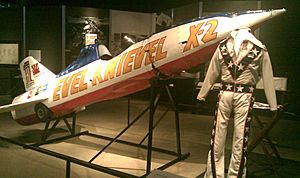
Since ABC wouldn't pay what Knievel wanted for the Snake River Canyon jump, he hired a boxing promoter to broadcast it on closed-circuit television. Knievel hired an engineer to build a rocket-powered cycle called the Skycycle X-2.
The launch happened on September 8, 1974. As the Skycycle left the ramp, its parachute opened too early. This caused it to slow down a lot. Even though the craft made it across the canyon, strong winds pushed it back. It landed only a few feet from the water at the bottom of the canyon. Knievel survived with only minor injuries.
Since 1974, several daredevils have wanted to recreate the jump. In 2016, stuntman Eddie Braun successfully jumped the canyon using a replica of the Skycycle X-2.
Wembley and Kings Island Jumps
After the Snake River jump, Knievel returned to motorcycle jumping. On May 26, 1975, he crashed at Wembley Stadium in London. He was trying to jump over 13 buses. After the crash, he broke his pelvis. Despite the injury, Knievel walked off the field, saying, "I came in walking, I went out walking!" He announced his retirement, but it didn't last long.
On October 25, 1975, Knievel jumped 14 Greyhound buses at Kings Island in Cincinnati, Ohio. He landed successfully, setting a record for jumping the most buses on a Harley-Davidson. This event had the highest viewer ratings ever for ABC's Wide World of Sports. It was Knievel's longest successful jump at 133 feet. After this, he announced his retirement again, but still continued to jump.
The Shark Jump and Retirement
On January 31, 1977, Knievel planned a big jump in Chicago. He was supposed to jump a tank full of live sharks. During rehearsal, Knievel lost control and crashed into a cameraman. Knievel broke his arms and was very upset about the cameraman's injury. This crash footage was so upsetting that Knievel didn't show it for 19 years.
After this, Knievel retired from major performances. He focused on smaller shows to help his son, Robbie, start his career. His last stunt show was in March 1980. He officially finished his daredevil career by touring with Robbie and giving speeches, but not performing stunts.
Evel Knievel's Motorcycles and Gear
Knievel used different motorcycles throughout his career. He started with a Honda 250cc, then a Norton Motorcycle Company 750cc. From 1967 to 1968, he used a Triumph Bonneville T120. He used the Triumph during his famous Caesars Palace crash.
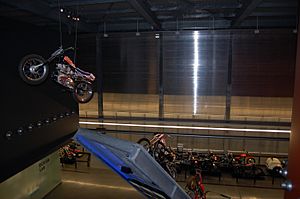
From 1969 to 1970, he used a Laverda American Eagle 750cc. On December 12, 1970, Knievel switched to the Harley-Davidson XR-750. This is the motorcycle he is most famous for jumping. He used it until 1977.
Knievel's jumps were often dangerous because his motorcycles' suspensions were not designed for such huge impacts. This caused many of his crashes and injuries.
Besides motorcycles, Knievel was known for his unique leather jumpsuits. He started with black and yellow, then switched to white suits with stripes. He wanted to be a showman, like Liberace. His white suits often had stars and later a V-shape design. He also added a red, white, and blue cape and an Elvis-style belt buckle. For the Wembley jump, he wore blue leathers with red stars.
Important Values and Safety
Evel Knievel was very proud of his core values. He often talked about the importance of "keeping his word." He said he always followed through with his stunts, even if he knew they were dangerous. He felt it was important to do what he promised.
Knievel was also a strong supporter of motorcycle helmet safety. He always encouraged his fans to wear helmets. The Bell Star helmet he wore during the Caesars Palace jump is believed to have saved his life. He even offered a reward to anyone who saw him stunting without a helmet. In 1987, he supported a law in California that made helmets mandatory. He said wearing a helmet was the main reason he was still alive.
Evel Knievel's Fame and Legacy
Knievel became a huge celebrity, especially among young boys. He wanted to earn money from his image. He signed endorsement deals with companies like American Eagle Motorcycles. Several films were made about his life, including the 1971 movie Evel Knievel starring George Hamilton.
Evel Knievel Toys
Between 1972 and 1977, Ideal Toy Company released many Evel Knievel toys. The most famous was the Evel Knievel Stunt Cycle, released in 1973. It became Ideal's best-selling item. They also released a Robbie Knievel doll and other stunt-related toys. These toys were very popular and sold millions of dollars worth.
In 1977, Bally also made an Evel Knievel pinball machine.
Other Appearances and Tributes
Knievel appeared in TV commercials, including for AMF bicycles. A children's animated series called Devlin, inspired by his popularity, aired in 1974.
He was a frequent guest on talk shows like The Tonight Show. In 1977, he appeared on The Bionic Woman, playing himself. He also starred in the 1977 movie Viva Knievel!. More recently, a character in Disney/Pixar's Toy Story 4, Duke Caboom, was partly based on the Evel Knievel toy.
Family Life
Evel Knievel was married twice. He and his first wife, Linda, were married for 38 years. They had four children: Kelly, Robbie, Tracey, and Alicia. His sons, Kelly and Robbie, performed in his stunt shows when they were growing up. Robbie continued to be a professional motorcycle daredevil as an adult. After Evel's death, Kelly has helped manage his father's legacy.
In 1999, Knievel married Krystal Kennedy. Their wedding was held on a platform built on the fountains at Caesars Palace, where he had his famous jump. They divorced in 2001 but later lived together until Knievel's death.
Later Years and Health
In the 1980s, Knievel traveled around the country selling art. In the 1990s, he made a comeback in marketing, working with companies like Harley-Davidson. In 1999, he was inducted into the Motorcycle Hall of Fame.
Knievel had dreamed of opening an Evel Knievel Museum in Montana. While that dream wasn't fully realized, his items are now in various museums. The Evel Knievel Museum in Topeka, Kansas, has official approval from his family.
In the late 1990s, Knievel needed a liver transplant due to Hepatitis C. He received a transplant in 1999. In 2005, he was diagnosed with a serious lung disease called idiopathic pulmonary fibrosis. He also had two strokes after 2005.
In 2007, he appeared with his son Robbie at "Evel Knievel Days" in Butte. Robbie performed a tribute jump for his father. A BBC documentary called Richard Hammond Meets Evel Knievel was filmed in July 2007 and aired shortly after Knievel's death.
Death
Evel Knievel passed away in Clearwater, Florida, on November 30, 2007, at age 69. He had been battling diabetes and lung disease for many years. A friend said he had trouble breathing on the way to the hospital.
Knievel was buried in his hometown of Butte, Montana, on December 10, 2007. His funeral was held at the Butte Civic Center. Fireworks exploded as his casket was carried into the center.
Posthumous Recognition
On July 10, 2010, a special exhibit called True Evel: The Amazing Story of Evel Knievel opened at the Harley-Davidson Museum in Milwaukee. It featured many items from Knievel's life, including his motorcycles and jumpsuits.
On September 17, 2016, stuntman Eddie Braun successfully jumped the Snake River Canyon. He used a replica of Knievel's rocket. Braun said Knievel was his inspiration and he wanted to show that Knievel's jump would have worked if the parachute hadn't opened early.
In 2017, the Evel Knievel Museum opened in Topeka, Kansas. It displays his motorcycles, helmets, and other items. It also has a virtual reality motorcycle jump experience.
On July 8, 2018, Travis Pastrana from Nitro Circus paid tribute to Evel. He recreated three of Evel's most famous Las Vegas jumps in one night. He rode an Indian Scout FTR750 and wore a full Evel Knievel outfit.
Television Commercials
In November 2010, General Motors used footage of Knievel's Wembley Stadium crash in a TV commercial. The ad showed Knievel getting back up, focusing on GM's comeback. In 2012, Audi of America recreated Knievel's Snake River jump for a commercial. It showed an Audi RS5 car jumping the canyon.
Portrayal in Film
- Evel Knievel (1971): A movie about his life, starring George Hamilton as Knievel.
- Viva Knievel! (1977): A fictional story starring Evel Knievel as himself.
- Evel Knievel (2004): Another movie about his life, starring George Eads as Knievel.
- I Am Evel Knievel (2014): A documentary film.
- Being Evel (2015): A documentary film.
- Richard Hammond Meets Evel Knievel (2007): A television documentary.
See also
 In Spanish: Evel Knievel para niños
In Spanish: Evel Knievel para niños
- Evel Pie, an Evel Knievel–themed restaurant in Las Vegas
- Devlin (TV series), an animated TV series inspired by Evel Knievel
- List of Evel Knievel career jumps


